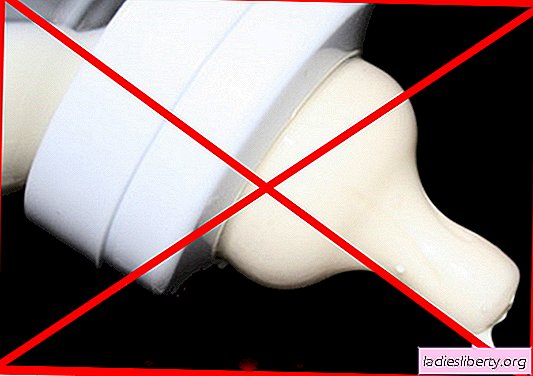
Even during pregnancy, young mothers are worried about many questions to which they are desperately trying to find the right answer.
After all, every mother wants her child to be born and grow up healthy, and develop accordingly to age.
One of the important issues is breastfeeding.
Today, there are many different theories and tips on how to feed your baby.
But besides the recommendations of specialists, every woman should listen to the requirements of her child.
Proper breastfeeding is the key to the successful development of the newborn.
How to feed a newborn: on the clock or on demand?
Everyone knows that the composition of breast milk is unique and in it you can find all the necessary vitamins and minerals for the full growth and maintenance of the health of small crumbs. But every mother (sometimes even an experienced one) has the question of how to feed her baby:
• by mode;
• at the request of the baby.
Unfortunately, there is no single answer. In this case, the opinions of experts were divided.
Very often, from pediatricians with many years of experience or from the older generation, you can hear that the child needs to create the right diet, and feed him strictly by the hour. The interval between feeding should be 3-4 hours (8-6 times a day), regardless of whether the child is sleeping or not. Adherents of this theory argue that the benefits of hourly feeding are as follows:
• children do not have problems with the gastrointestinal tract;
• they cannot be overfed;
• You can not be afraid that the children will be spoiled and constantly ask for breasts.
Of course, over time, many children manage to get used to this regimen, and they try to drink so much milk that they have enough until the next meal.
But nevertheless, there is a category of children who cannot get enough at one time (this may be due to the amount of milk produced by the mother), so it is impossible to draw up a clear schedule. Modern pediatricians in such situations are advised to feed the baby on demand. It is no secret that the amount of milk released is directly proportional to how much the child eats. The more often the mother puts the baby to the breast, the stronger the lactation.
The body of each baby is individual, so mothers need to determine for themselves how to properly feed the newborn by its nature.
1. If the child is active enough, often cries and briefly holds his chest (or falls asleep immediately) - you need to feed at the first request, since the crumbs may simply not be full.
2. If the child is calm, sleeps a lot and does not bother his parents with a cry, he can be fed, adhering to a certain regimen.
It is important to know! Modern doctors do not recommend waking up a baby for food, regardless of whether it is fed on schedule or on demand. They also argue that if a child ate well and voluntarily released his chest, then a feeling of hunger will come to him no sooner than after 1.5 - 2 hours, therefore you should not force-feed him at the first cry, there can be many reasons for tears.
How to feed a newborn with breast milk?
The breasts of women change during pregnancy. Future mothers closer to birth crumbs get used to new forms and sensations. The benefits of breastfeeding are obvious to everyone. Such milk contains the right balance of nutrients for the baby.
What is the benefit of breast milk?
• it is easier to digest than unit milk substitutes;
• has many necessary antibodies for the formation of the baby’s immune system;
• helps to form the first microflora in the intestines of the baby.
But breastfeeding a baby can be quite a challenge for young mothers. Immediately after the birth of a newborn, women do not have "real" breast milk, and so-called colostrum is secreted. This is a very useful substance for children, as it is, it is quite nutritious, has a huge amount of proteins and vitamins and is quickly absorbed by the baby’s body. During colostrum, the mother often needs to put the baby to her chest in order to quickly establish a system for producing breast milk.
After about 2 days, milk begins to appear in the mother’s chest. It is then necessary to decide how to properly feed the newborn. The process of establishing breastfeeding is quite complicated, and if within three days after the period of colostrum milk has not appeared, or if it is very small, it is received irregularly, it is necessary to buy a mixture for feeding the baby.
If milk enters the breast regularly and the baby is saturated at one meal, you need to adjust the feeding schedule, either at certain hours, or at the request of the newborn. It is important that the baby is well developed and correctly gaining weight. Even in the maternity hospital, nurses will explain how to properly place the baby on the chest and how to feed it.
Rules for applying the baby to the chest

• it is necessary that the baby grab not only the nipple, but also part of the areola;
• the chin is firmly pressed to the mother’s chest;
• the nose rests on the chest, but there is free access of air.
Feeding time already depends on the baby. There are children who immediately actively suck the nipple and quickly eat enough. But also babies with a calmer character are born, which can stretch the feeding period for a long time.
How to feed a newborn from a bottle?
Another problem that mothers face is how to properly feed a newborn with a bottle. If breastfeeding for one reason or another is not possible (the mother does not have milk, she needs to go to work, etc.), the parents switch to infant formula. But before choosing a mixture, it is very important to consult your doctor, it will be he who will tell you what type they are suitable for a given age.
To feed a baby from a bottle, some feeding rules must be added:
• First you need to sit comfortably with your child.
• Do not put it on your back so that the baby does not choke.
• It is best to put the baby on your lap, hugging it tightly so that the head is slightly higher than body level.
• The position of the baby should be natural and reminiscent of the position when breastfeeding.
• The child’s head cannot be turned to one side, as this position will cause difficulty in swallowing.
• Try to make eye contact with the baby in order to control the feeding process.
The bottle itself must be held tightly in a horizontal position under a small heap so that the milk does not fill the entire nipple.

It is necessary that the baby correctly grasped the elongated part of the nipple. It is very important that in this part there is always milk, and not air, in order to avoid colic.

In time, the feeding process may be different; if the child is very hungry, he will eat actively. If the baby has a calm temperament and periodically pauses between sucking, the feeding time may be delayed. If a child falls asleep with a bottle in his mouth, carefully remove it so that he does not choke in his sleep. Also, kids take breaks in order to feel if there is still a feeling of hunger. Since together with the mixture they swallow air, it is important to allow the child to burp. If after this the baby again takes up the bottle - do not worry, he is really still hungry.
It is important to know! Proper feeding from the bottle occurs when bubbles form in it. If you do not see any bubbles and the nipple is already stuck from active sucking, you need to carefully remove the bottle from the mouth. In cases where the baby firmly grasped the bottle and does not want to let it go, you need to slowly insert a clean finger between the lips of the newborn so that air enters the bottle.
After the feeding process, it is necessary that the excess air leaves the baby's body. To do this, place the baby on the shoulder and gently massage the back or pat on it. Do not forget that some milk will come out with the air. Therefore, stock up on napkins or a handkerchief.

How to feed a newborn: mistakes of young mothers
1. Fear of seeking help.
At first, feeding a baby for some mothers may turn out to be the easiest task, for others it’s quite a difficult and painful process. It often happens that women are shy or afraid to seek help from specialists or other more experienced mothers. From this, problems arise not only with feeding and lactation, but also with the condition of the breast itself. If you have questions, it is important to immediately find the answer either to a special lactation consultant or to more experienced women. After all, improper attachment to the chest leads to the loss of milk, refusal of the breast, colic and a number of other troubles.
2. Short feeding time.
It often happens that while breastfeeding the baby falls asleep after 10 minutes. Young mothers, hoping for a moment of rest, do not want to wake the baby and stop eating. This option is not entirely true, because at first, more liquid carbohydrate-rich milk is released from a woman's breast. And in order to get a portion of the necessary vitamins and minerals, it is necessary to feed the child for 20-25 minutes (with active sucking). It is then that all the necessary proteins and fats for the proper development and growth of crumbs will enter the baby's body.
3. Feeding regimen.
When breastfeeding or unit feeding, you need to make sure that the baby receives enough food at one meal. This contributes to the normal functioning of the gastrointestinal tract and allows you to set an approximate feeding schedule. If the baby does not eat up at once and constantly asks to eat (and this process can last for 2 hours), his small stomach is constantly in tension, secreting a large amount of gastric juice. Which over time can lead to some health problems.
4. Additional amount of water.
Many people believe that breast milk is water, and the baby needs to be given extra water or light compotes to maintain the correct water balance in the body. This is actually not the case. Milk consists of 80-90% of water, especially that which is excreted in the first 10 minutes of feeding. Thanks to these properties of milk, the baby does not feel thirst. Moreover, soldering a baby from a bottle, another problem may arise - the baby refuses to breast. All this happens because when sucking from the chest, more muscle is involved than from the bottle. So the baby just simplifies the task by requiring a bottle.
5. Lack of bodily contact.
Many mothers are afraid to feed the baby in their arms so as not to spoil it. This is the main mistake. For newborns, a very important bodily contact with mom, as this helps him to feel protected.
Unfortunately, there is no universal answer to the question of how to properly feed a newborn, but experienced specialists, relevant literature, mother’s love and care will help the baby grow up healthy and happy.











